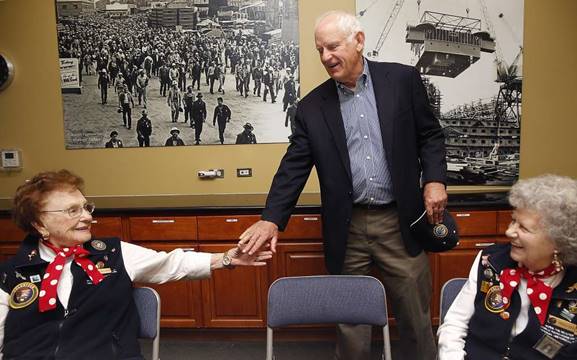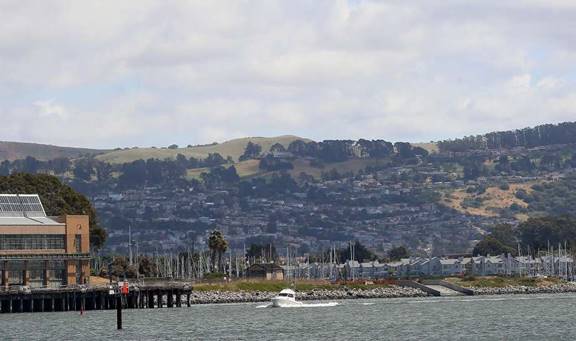|
| One correction, any project on the site does not have to be apartments; it could be either apartments or ownership housing, but it does need to be denser to conform to the vision of the General Plan 2030. Density and mixed use is the issue, not rental units.
http://www.sfchronicle.com/bayarea/article/Richmond-fights-for-apartments-but-developer-7940868.php#photo-10116831
Richmond fights for apartments; developer wants ‘Riviera’ homes
By Rachel Swan
May 23, 2016 Updated: May 23, 2016 5:16pm

Richmond Mayor Tom Butt walks through the Rosie the Riveter/WWII Home Front National Historical Park Visitor Center next to the five acre controversial Richmond Riviera project in Richmond, California, on Friday, May 20, 2016. He meets with Richmond Kaiser Shipyard #3 journeyman welder Agnes Moore (left), 1942-1945, and Richmond Kaiser Shipyard #3 electrician Priscilla Elder (right), 1943-1945. Developer is planning to build 59 luxury homes seeking support through a ballot measure. Mayor Tom Butt would rather support ideas suited towards the historic past shipyard such as this museum
Photo: Liz Hafalia, The Chronicle
Richmond Mayor Tom Butt opposes the project. He says the proposed development “is totally inappropriate.”
A developer’s plan to build single-family houses on Richmond’s waterfront — walking distance from a future ferry to San Francisco — is the focus of a fierce political battle over how much housing will get built in the East Bay city.
The city would rather pack the waterfront with high-density apartment buildings and offices than the 59 homes that developer and landowner Richard Poe wants to build.
So Poe has turned to the voters, pushing an initiative on the June ballot that would allow him to subvert the city’s general plan and build what he calls the Richmond Riviera: a tight-knit cluster of town houses and manicured gardens around a bustling waterfront promenade.
Poe’s Measure N would loosen the city’s general plan that calls for high-density apartments and office buildings near transit corridors so that his project could sail through.
The initiative faces stout opposition from City Hall, where officials say it would reshape Marina Bay, and they also fear it would affect other big projects throughout the city.
“The development he’s proposed is totally inappropriate,” said Mayor Tom Butt, who has donated $2,500 to defeat Measure N. “It’s basically a suburban, almost rural project in an area that should be focused on high-intensity building.”

Photo: Liz Hafalia, The Chronicle
The 5-acre “Richmond Riviera” site (beyond the boat) would include 59 single-family homes in an area some feel would be better served by apartments.
But Poe has rallied support from a staunch group of Richmond residents, including parents and teachers at the Amethod charter school network, which runs three schools in the Marina Bay area. Poe has promised to donate an acre of land to provide at least 30 affordable dwelling units to teachers. These apartments wouldn’t be part of the Riviera single-family home community.
The fight comes at a pivotal time for Marina Bay, a well-heeled, postcard-ready enclave in a city long known as a working-class stronghold. With the ferry scheduled to begin service next year, and the University of California planning to open a campus on the east side of the Marina Bay shoreline, some residents worry their sleepy neighborhood will become a commuter hub.
High density vs. low key
“There’s been a lot of play about this on social media, particularly NextDoor,” Butt said. “In the Marina Bay you have this small core of NIMBY people who want Marina Bay to remain as low-key and laid-back as it can be. They say if you’re gonna build something, build as little as possible.”
Paula Riddell, whose daughters attend two of the charter schools, said that she fears the Marina Bay neighborhood will draw in a “transitory population” if it is honeycombed with apartments — the city’s general plan makes room for up to 600.
“Apartment renters have no deep roots. ... They won’t go that extra mile to pick up trash on the ground, or cut the grass, or plant flowers,” Riddell said. “Single-family homes are where your foundation is.”
Yet Richard Mitchell, the city’s director of planning and building, said that because Measure N changes the general plan, it could enable density reductions at other key development sites — such as the 65-acre Hilltop Mall and the shared BART and Capitol Corridor train station.
Contrary to urban plan
“The Riviera project goes against all the thinking in urban plan work for the last 30 years,” said Eli Moore, a researcher at UC Berkeley’s Haas Institute for a Fair and Inclusive Society who co-authored a 2015 report on gentrification in Richmond.
“If you look at it from any angle — job creation, greenhouse gas emissions, quality of life, economic vibrancy of the neighborhood — higher density (building) is much more beneficial in a location like that, so close to the region’s core,” Moore said.
Close to future ferry
Nestled near the future ferry terminal, the popular Craneway Pavilion and the Rosie the Riveter WWII Home Front Center, the Riviera site has become a fraught symbol of Richmond’s future. The city is rapidly attracting new investment, and the new ferry terminal will dramatically shorten the commute distance between Richmond and San Francisco.
“Given the Bay Area housing crisis, the ferry will make Richmond a lot more appealing to people who work in San Francisco,” Moore said.
While city officials welcome that economic growth, some residents foresee a grim future of traffic jams and high-rises that blot out the sun.
“If you put hundreds of units there, the traffic is going to be ridiculous,” said Kevin Murphy, a retired businessman who lives in Marina Bay.
The “Yes on N” campaign plays on those fears, with a website that promises to stand in the way of tall buildings and strip power “from the politicians and lobbyists who have ruined Richmond for far too long.”
Good-looking prospects
“It’s going to look like the rest of the housing in Marina Bay,” said Murphy, who backs Measure N. “If you’re out taking your sailboat along, it’s going to look good. If you’re (walking) on the Bay Trail, it’s going to look good.”
Poe, who once lived in Richmond but has moved to Florida, said he named his project for the Mediterranean climate and “nautical theme” of the waterfront. Besides the teacher housing, he’s promised to outfit the 59 single-family homes with forward-thinking environmental features, such as solar panels, drought-resistant landscaping and electric car charging stations.
“The social benefits for this project outweighs the economic benefits,” he told The Chronicle last week. He said the houses will likely go to middle-class families.
Butt disagreed. “I don’t think it’s the middle-class that we know around here,” he said. “These houses will probably go for a million dollars each.”
Poe said that if his ballot measure doesn’t pass, he may wind up filling the shoreline property with office buildings.
Rachel Swan is a San Francisco Chronicle staff writer. Email: rswan@sfchronicle.com |
|

